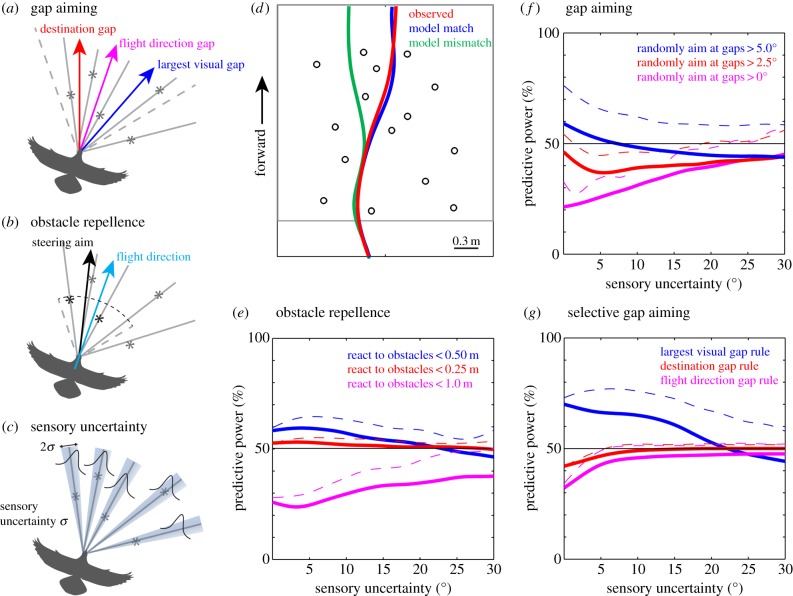Figure 4.
Pigeons bias their flight paths towards largest gaps. (a) Based on the gap-aiming paradigm, we proposed three potential guidance rules: (1) steer to the gap closest to the destination direction (red), (2) steer to the gap in the existing flight direction (magenta) or (3) steer to the largest visual gap (blue). (b) To establish a reference for our gap-aiming paradigm, we reconstructed a conventional obstacle repellence model with a variable range attention zone (marked by dashed lines), in which the repellent effects from all obstacles within that threshold range and angle were summed. (c) To provide the simulations with more realistic sensory information, we incorporated sensory uncertainty by assuming a Gaussian distribution centred at each obstacle position for the model to sample from. The standard deviation of this Gaussian distribution was varied to test each steering strategy across a range of noise levels. (d) We simulated 40 pigeon flights (not used for steering controller tuning) given only the initial conditions (i.e. body position, flight direction, entry speed) 0.5 m before the obstacle field. Some simulations recapitulated the observed flight trajectories (blue trace) and some did not (green trace). We quantified the percentage of flight trajectory matches for each guidance rule in each simulation set (40 flights). To examine the effect of sensory uncertainty, we ran each simulation set 100 times under each sensory uncertainty condition. (e) We varied the threshold range of the obstacle repellence model and found that a threshold of 0.5 m yielded the greatest mean predictive power of 58% with zero noise (solid blue line). The corresponding maximum predictive power (blue dashed line) reached 64% at 6° sensory uncertainty. The obstacle repellence model's predictive power was lower when reacting to the obstacles too late (less than 0.25 m) or too early (less than 1 m). (f) The gap-aiming navigational paradigm requires that pigeons always aim to a gap between two obstacles. In this set of simulations, the modelled pigeon randomly aims to a gap over a given angular size threshold. As the threshold increases, the predictive power increases for sensory uncertainty ranging from 0 to 20°, signifying the importance of gap size in the decision-making process. (g) Maintaining the gap size threshold at 5°, we ran simulations using the three basic guidance rules described in (a). The destination gap rule and flight direction gap rule both underperformed compared with random gap selection as in (f). The maximum predictive power of those simulations where the model pigeons aimed for the largest visual gap, however, approached 80% around a noise level of 6°, outperforming the alternative gap selection rules, random gap selection (f) and the obstacle repellence model (e).

